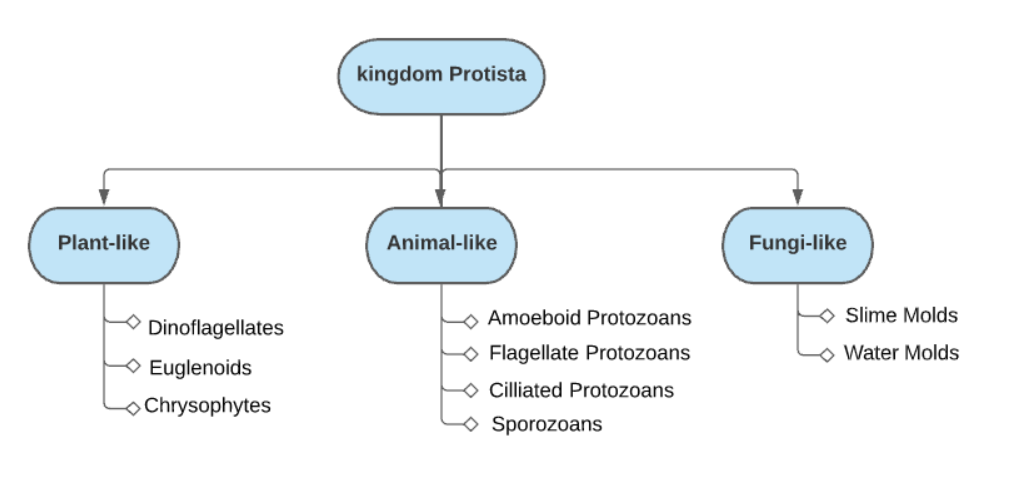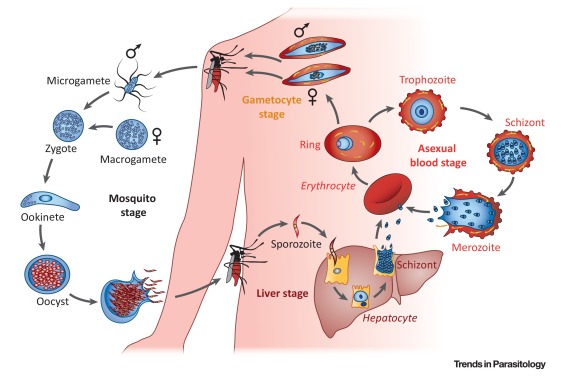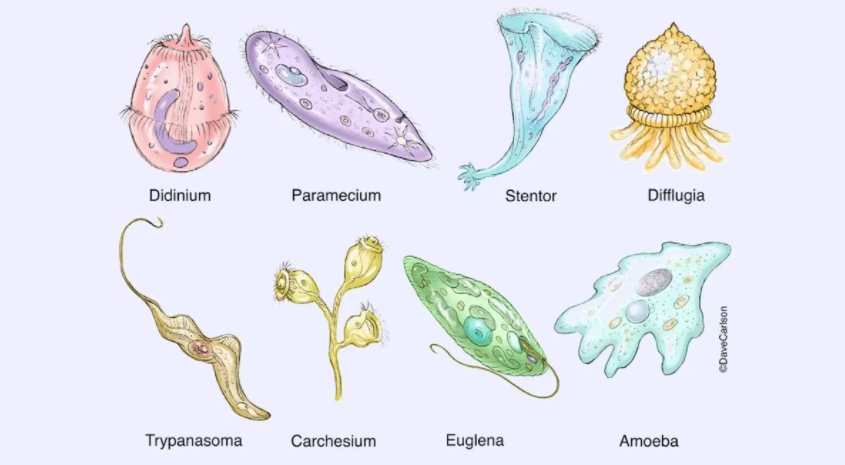Protists and Disease Study Guide
Introduction
Protists are unicellular eukaryotic organisms and they are grouped in a separate kingdom named ‘Protista.’
- Protists are primarily aquatic organisms present in marine or freshwater environments.
- They are also present on damp terrestrial areas, decaying leaves, etc.
- They are autotrophic, heterotrophic, or both, and they reproduce asexually and sexually.
- Usually, harmful protists are animal-like protists that act as parasites in humans.
Some of the common examples of protists are:
- Chrysophytes – They are photosynthetic plankton. E.g., Diatoms and golden algae.
- Dinoflagellates – They are mostly marine and photosynthetic, and they show bioluminescence. Rapid multiplication of some species causes red tide, e.g., Gonyaulax.
- Euglenoids – They are mixotrophic, i.e., they show autotrophic as well as heterotrophic modes of nutrition. E.g., Euglena.
- Slime molds – They are saprophytes. They form aggregates called plasmodium. They are like fungi.
- Protozoans – They are heterotrophs, live as parasites or predators. E.g., Amoeba, Paramecium, Plasmodium, Trypanosoma, etc.
Classification
Protists can be classified as:
- Animal-like
- Plant-like
- Fungus-like
How are protists harmful?
Can little creatures like protists cause sickness? Not all of them, but some of them cause sickness, and if not given proper medical treatment, the affected person may succumb to the illness. Protozoa cause most protist diseases in human beings. Protozoa cause sickness in humans when they become parasites.
Diseases caused by pathogenic protists
a. Trypanosoma Protozoa: Members of the genus Trypanosoma are flagellate protozoa cause:
- Sleeping sickness, which is common in Africa.
- Chagas disease, which is common in South America.
Trypanosoma parasites enter a person’s blood after the infected mosquito bites, and they then spread to other tissues and organs. The disease can be fatal for the infected person if not provided with medical treatment.
b. Giardia Protozoa: Giardia are flagellate protozoa that cause Giardiasis. The parasites enter the body through food or water contaminated from the feces of infected people or animals. The Giardia protozoa get attached to the host’s small intestine’s lining, preventing the host from absorbing nutrients. Giardia protozoa can also cause abdominal pain and fever.
c. Plasmodium Protozoa: The protist Plasmodium protozoa cause malaria.
The parasites are spread by infected mosquitoes, whose bite ingests the parasites into the host’s blood. These parasites infect the host’s red blood cells, causing fever, joint pain, anemia, and fatigue. Malaria is one of the most common infectious diseases, commonly seen in tropical and subtropical climates worldwide. It kills several million people each year, most of them being children.
Prevention and Protist Treatment
The first step to avoid these diseases is to adopt effective ways for prevention. These include washing hands frequently, avoiding contact with infected or sick individuals, and coughing or sneezing into a tissue or your sleeve, but not into your hands or the air.
1. Malaria treatment: Malaria infection can be prevented by protecting against mosquito bites. People use mosquito nets and apply insect repellents to their skin to avoid bites. Antimalarial drugs help treat the symptoms and can prevent further infection. The antimalarial drugs include Mefloquine, Chloroquine, Proguanil with atovaquone, and Doxycycline.
2. Giardiasis: The first line of treatment is oral rehydration therapy to maintain body hydration. Medications are sometimes used to treat dysentery. The antiparasitic drug Nitazoxanide can be used to treat cryptosporidiosis. Other antiparasitic drugs that can be used include Azithromycin and Paromomycin.
3. Amoebic dysentery: Entamoeba histolytica causes Amoebic dysentery. It can also travel through the intestines’ walls, enter the bloodstream, and move to other organs like the liver, where it can cause liver abscesses.
4. African trypanosomiasis or Sleeping sickness: Preventive measures include:
- Wear protective clothing like long-sleeved shirts and pants
- Wear color-neutral clothing
- Inspect vehicles for tsetse flies before entering
- Avoid bushes
- Use insect repellent
The oral therapy, called Fexinidazole, cures 91% of people with severe sleeping sickness compared to 98% treated with the combination therapy. Fexinidazole also cured 99% of people in an early stage of the disease.
Conclusion:
- Protists are unicellular eukaryotic organisms
- Protists can be broadly classified as Animal-like, Plant-like, and Fungus-like
- Protists cause several illnesses, the key being: Sleeping sickness, Chagas disease (by Trypanosoma protozoa); Giardiasis (by Giardia protozoa); Malaria (by Plasmodium Protozoa)
- The first line of preventive treatment for protest caused sickness includes washing hands frequently, avoiding contact with infected individuals. There are specific medications available for treatments of Malaria, Giardiasis, Sleeping sickness, Chagas disease, and Amoebic dysentery.
FAQs:
1. What are 3 diseases caused by protists? What are two diseases caused by protists?
Protist parasites cause malaria, sleeping sickness, amoebic encephalitis, and waterborne gastroenteritis in humans.
2. What are 5 diseases caused by protists?
The five diseases caused by protists are:
1 Malaria. 2. African trypanosomiasis3. Chagas disease4. Leishmaniasis. 5. Toxoplasmosis6. Cryptosporidiosis
3. How do protists cause the disease GCSE?
Protists are passed from an infected person through mosquitos, and the mosquitos are called ‘vectors because they transmit the disease. The symptoms of malaria include fever, sweats and chills, headaches, vomiting, and diarrhea.
4. What are 3 ways protists are harmful to humans?
Some severe diseases of humans caused by protists (primarily blood parasites) are Malaria, Trypanosomiasis (African sleeping sickness), Leishmaniasis, Toxoplasmosis, and Amoebic dysentery.
5. Are protists harmful?
Many protists are harmful to humans, animals, and plants because they cause diseases and crop failures. However, some protists are beneficial and are used by humans for various purposes.
6. How do protists cause damage to the body?
Protozoa cause most protist diseases in humans. Trypanosoma protozoa cause Chagas disease and sleeping sickness. Giardia protozoa cause giardiasis, and Plasmodium protozoa cause malaria.
7. Are protists beneficial or harmful?
Tome protists are harmful, as they cause severe diseases like Malaria, Sleeping sickness, Amoebic Dysentery.But many protists are beneficial, as they are the foundation for food chains, produce the oxygen we breathe, and play an important role in nutrient recycling.
8. How are protist diseases treated?
- Malaria treatment – Antimalarial drugs are administered to treat the symptoms and prevent further infection. The antimalarial drugs may include Mefloquine, Chloroquine, and Doxycycline, which are used to treat and prevent malaria.
- Giardiasis – The first line of treatment is oral rehydration therapy to maintain body hydration. The antiparasitic drug Nitazoxanide can be used to treat cryptosporidiosis.
- African trypanosomiasis or Sleeping sickness – Fexinidazole oral therapy cures 91% of people with severe sleeping sickness. Experts say four drugs are available to treat African trypanosomiasis or sleeping sickness: Suramin, Pentamidine, Melarsoprol, and Eflornithine.
We hope you enjoyed studying this lesson and learned something cool about Protists and Diseases! Join our Discord community to get any questions you may have answered and to engage with other students just like you! Don’t forget to download our App to experience our fun, VR classrooms – we promise, it makes studying much more fun! 😎
Sources:
- Protists and Disease https://flexbooks.ck12.org/cbook/ck-12-biology-flexbook-2.0/section/8.7/primary/lesson/protists-and-human-disease-bio/ Accessed on 9 Dec 2021
- Pathogenic Protists https://courses.lumenlearning.com/wmbiology2/chapter/pathogenic-protists/ Accessed on 9 Dec 2021
- Protozoa and the Illnesses They Cause. https://www.verywellhealth.com/definition-of-protozoa-1958837 Accessed on 9 Dec 2021



